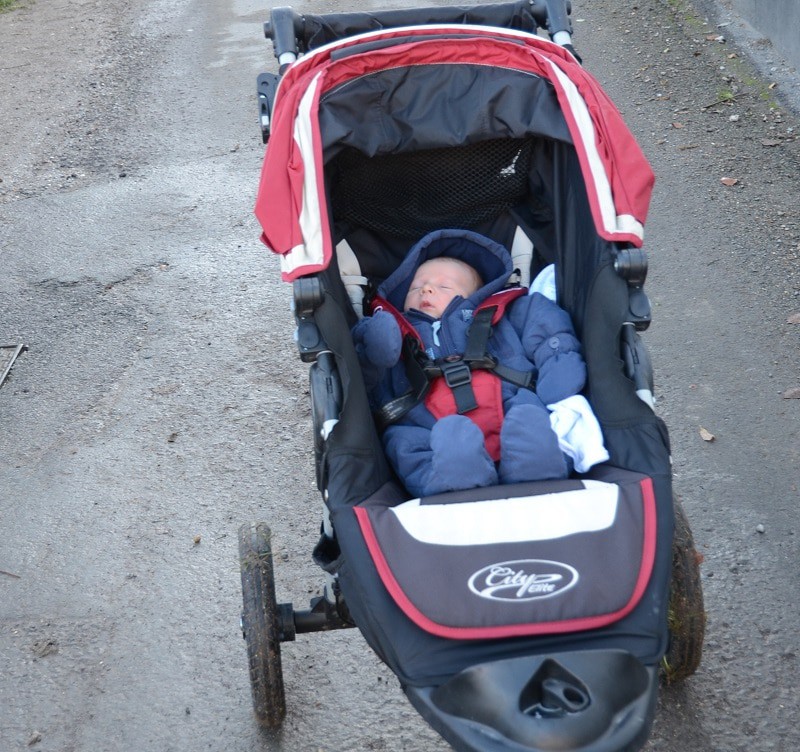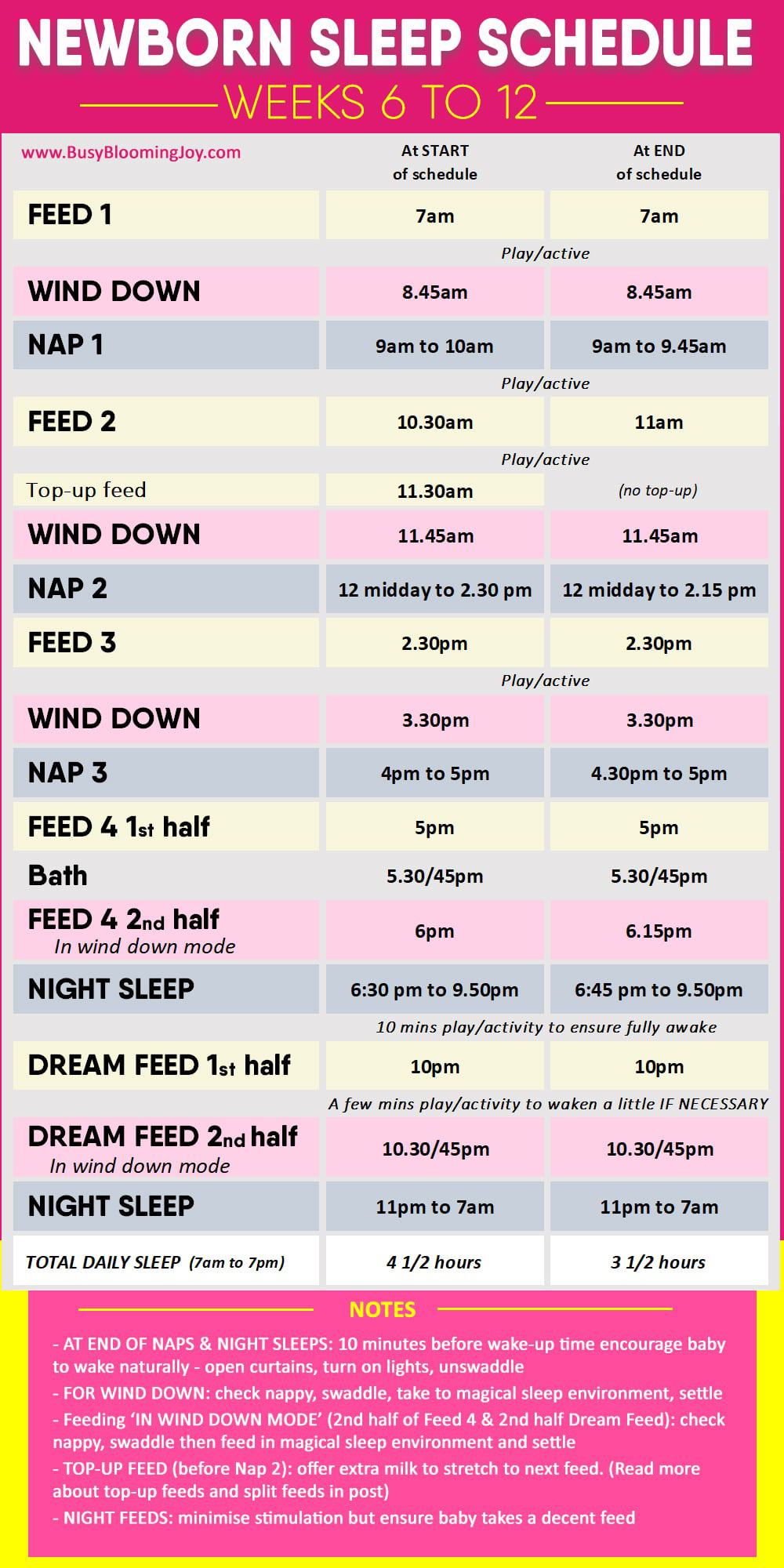Whether you are a fan of routine or not, I’m telling you that your wee-one will love this newborn sleep & feeding schedule. And while I get that every baby is different (my 2 were like chalk and cheese when it came to sleep) they can still ‘follow’ the same routine.
I say ‘follow’ because, like many, many things baby, it should be treated as a ‘guide’ and adjusted as and when necessary.
If your baby is balling her eyes out with hunger before the schedule says it’s feed time, feed that baby! Just wanted to clear that up.
And while the sleep schedule itself is simple – it’s just a list of when to do what – it’s good to understand the underlying principles on which it’s built.
Sticking to these principles will ensure that even if you have a day here and there freestyling and lose all sight of the schedule (it will happen!) then you will still be on track in the long term aim of aiding the development of healthy sleep habits and getting your baby to sleep through the night.
(These principles alone are the basis for the strategy outlined in this post: How to get your baby to sleep through the night: 10 steps for an awesome nights sleep, no cry-it-out. So if you want the glory of a good nights sleep and you’re still not sure about a newborn sleep schedule you could just start there.)
Table of Contents
ToggleWhy start a sleep & feeding schedule with your newborn
Well there’s one HUGE reason out the bag already; it will encourage your baby to develop healthy sleep habits and sleep through the night.
Both my babies started sleeping through the night at 3 months old following this exact schedule. Both were breastfed in case you were wondering.
Beyond that, a well-rested, well-fed baby is a happy healthy one!

And there are big reasons for you too: some sense of predictability and normality in the full-on world of motherhood.
If you have a toddler who still naps in the day, then by using a sleep schedule with both, they should both take the same afternoon. Yup, I did it with mine.
Because I so firmly believe that a newborn sleep schedule is absolutely the way to go, there will be a post on this very soon.
My sleep and feed schedule experience
Baby NO. 1
I started a schedule with my firstborn when he was 3 weeks old and it then took about 3 weeks to establish the sleep and nap times. By the time he was 8 weeks old he followed it like clockwork!
At 3 months old he was sleeping through the night and settled for all his naps and in the evening completely unaided. He’s napped and slept well ever since.
Baby NO. 2
My daughter was rather a different story as she had reflux. I started it with her at about 2 weeks old and it only took around 10 days to establish. But we probably had more days off track than on, definitely not clockwork!
In reality, it was a very loose schedule and on those freestyling days I just tried to stick to as many of the 10 principles (coming up below) as possible.
The both of us still reaped many of the benefits of following a sleep schedule: she started sleeping through at 3 months and was generally well-rested. And I’m sure that following a schedule helped minimize the discomfort of the reflux.
Unlike my son, she’s also very strong-willed. From about 20 months she started resisting her afternoon nap. Having started a schedule so early and sticking to it as best I could EVERYDAY through the ages and stages, she still takes her nap at 26 months, though often somewhat reluctantly.
(As toddlers develop their own personality and opinion, sleepytime rituals and routines become more and more important, but the wondrous world of toddler sleep and routines is one for another day.)
Some words of caution & advice before starting
This schedule will likely take some time to implement. It takes hard work. It’s not an overnight quick fix.
I don’t want to sugarcoat it.
1 – Give it your best shot!
If you’re going to try it, really try it. Every day. For at least a month.
You will probably love it. You may adapt it along the way to your own version. At the very worse you throw in the towel (please don’t). But if you do, I will guarantee two things:
- You will more easily recognize if your baby is tired, hungry or overstimulated (because you have more of a handle of when things happened last)
- Your baby will sleep better, they just will
You will regularly have days when you go totally off schedule (I called it freestyling – made it sound like I intended it to happen).
Forget about it, start the next day afresh.
2 – Read the 10-principles and other notes before getting started – they’re important!
Don’t just skip to the schedules and miss out all the important stuff in between.
It’s not just about the timings – there are ways and means and reasons for why things happen at certain times. If you understand these bits and bobs you will be much more successful in getting started and be able to adjust as necessary.
3 – If you have an older baby, check the earlier schedules to see where to start
Don’t assume that because your baby is 6 weeks old, he or she should start on the 6 to 12-week schedule.
Check the 3 to 6-week schedule and see if that’s more appropriate.
10 UNDERLYING PRINCIPLES you need to understand
As I mentioned earlier, understanding these principles and sticking to them will ensure that even if you go off schedule, you will still be giving your baby the best chance of developing healthy sleep habits and working towards getting your baby to sleep through the night.
#1 Swaddle – for all naps and at night

Swaddle baby for all naps and at night to stop the ‘Moro’ Reflex from startling baby awake. You can read about the Moro Reflex here.
#2 In the day the cycle is: milk, awake and active, then sleep
Feeding your newborn just after they wake up, when they are most awake and alert, encourages a decent milk intake.
This also reduces the possibility of a sleep association developing because feeding and sleeping are separated by some awake/active time.
There are occasions when feeding does occur just before sleep/nap time and that’s when feeding a ‘split’ feed or ‘top-up’ feed. More on this later.
In later schedules, there’s a short period of activity between waking up and feeding as your newborn is able to last longer between feeds.
#3. Make sure baby doesn’t miss day feeds
This is to minimize night wakings through hunger.
First of all, try to ensure baby takes ‘full’ feeds – you don’t want a snacker! More on this later.
Secondly, if you get behind on the schedule, DON’T MISS A FEED. Just try and catch up as best you can. If you do miss a feed, your newborn is almost certain to wake up more in the night to catch up.
#4 Keep an eye on daytime sleep
Letting your newborn sleep too long at one nap is easily done! If you’ve got a toddler keeping you busy, you’re out in the car or buggy or just want a few more minutes to yourself (that was me!) suddenly baby has slept an extra half an hour.
An extra half an hour or so here and there didn’t seem to upset either of mine when it came to their night sleep, but it obviously throws off feed times (as in #3 just try to catch up – don’t miss a feed).
But if baby significantly oversleeps at one nap (by an hour or more) and you find yourself wildly off schedule, reduce the nap times later in the day. Nap 3 could be cut from 1.5 hours to 45 mins for example. Still, try to ensure you fit the right number of feeds in to keep in line with #3.
The maximum day sleep is noted with each schedule, as well as in this post on baby sleep needs.
Related post: Baffled by how much sleep baby needs? Baby sleep chart to the rescue!
#5. Create a magical sleep environment EVERY NAPTIME with enough time for wind down
I’ve noted a window of wind down time before every sleep. ‘Setting the stage for sleep’ is a common expression, since that’s exactly what you want to do.
You want to create positive associations with sleep: low lighting, soft music, singing or humming a lullaby, swaddled = time to sleep.
Even in the day, try to ensure your newborn naps in a quiet, calm place and do your wind-down routine there.

At night, add in a bath, even some baby massage.
If out and about, try and replicate as much of your normal wind-down routine as possible.
#6. Learn when your baby is tired so you can act on it – let baby sleep ahead of schedule if necessary
One of the major benefits of following a feeding and sleep schedule is that you quickly learn why your baby is fussing. You can eliminate tiredness or hunger, knowing when the last feed or nap took place. Obviously, there are many other reasons for a baby to fuss, but at least you have a head start!
If you suspect your baby is tired ahead of a scheduled sleep time, let your newborn sleep early and avoid overtiredness. Maybe your baby needs a bit more sleep than average. Maybe they didn’t sleep as well at the last nap. Maybe it’s a growth spurt.
#7. Dream Feed
This is a feed last thing at night, right before you go to sleep, ensuring your newborns tummy is full and delaying the first night waking due to hunger. Sounds good, right?!
It’s termed a ‘dream’ feed because the idea is that you don’t wake baby fully, but just enough to take a decent feed.
However, during the first weeks, even months, it will be necessary to wake your baby as fully as possible to get them to take a feed! I battled with getting the dream feed to be anything more than a few cursory sucks for a long time before it became a ‘decent’ feed.
For this reason, in the schedule, I’ve noted to wake baby up fully just as you do in the day and wait 10 minutes before starting the feed, as well as feeding this as a ‘split’ feed, more on split feeds later.
Getting the dream feed right is key to YOU getting more sleep at night but can take some work, so much so I’ve shared my learnings from this here:
Related post: The Dream Feed: An insanely simple solution to dramatically more sleep
#8. Make sure the room your baby is sleeping in is pitch black FOR EVERY NAP
Light disturbs sleep… That combined with the fact that newborn sleep is very active and easily disturbed means that it’s common for babies to wake after 45 minutes (the light waking them in between sleep cycles).
In the day you want to encourage longer naps. 45 minutes is too short!
At night, you don’t want baby waking up at the crack of dawn.
Make that room dark.
#9. Pause
As mentioned at #8, babies are very active in their sleep and easily disturbed.
Don’t assume your baby is waking if kicking about or making a noise – your newborn maybe in ‘Active’ sleep or transitioning between sleep cycles. Give baby a chance to settle before inadvertently disturbing him or her.
Pause!
You can read more about the wacky world of newborn sleep here:
Related post: Newborn sleep simplified. The ULTIMATE guide to get you in the know
#10. Put down baby awake – NOTE: YOU CAN STILL FOLLOW A SCHEDULE WITHOUT DOING THIS
If baby is well-fed, tired but not overtired, you have settled them in their magical sleep environment, it really is possible to lie your baby down in their cot and he or she will go to sleep.
I also had my doubts, but it can be done.
I did it with my son very successfully and by 7 weeks he would settle himself for every nap. It did take a while for this to happen at every nap and I did use sleep aids to establish the schedule (see the ‘cheats notes’ that come after the sleep schedules). But it did happen!
My daughter, on the other hand, was a whole different story as she had reflux and was permanently uncomfortable…. Will save the tips for sleep with a reflux baby for another day.
So it’s also worth pointing out that you can still follow a newborn sleep schedule WITHOUT putting baby down awake – just know that it’s highly likely that baby will develop negative sleep associations (I.e. only able to fall asleep when being rocked or nursed) but that’s just something you will have to tackle later.
Split feeds & top-feeds
These are key to this newborn sleep schedule!
What’s a ‘split’ feed
A split feed is when you feed half/the majority of a feed, for example 1 breast or half/majority of the bottle, take a break for a certain period, and then nurse from the second breast or remainder of the bottle.
When still small and awake times are short, this means baby has the first half of the feed on waking and the second half of the feed just before sleeping.
Why a ‘split’ feed?
A split feed encourages baby to drink more milk in total; the break allows baby to build a little more appetite and drink more at the second sitting. With a fully tummy, this delays the timing of the next feed, allowing baby to sleep longer.
‘Top-up’ feeds
The concept is similar: offering additional/more milk shortly after a full feed in order to delay the next feed and allow a longer sleep
Feed 4 is a split feed at 5/6pm
A split feed is offered before the first ‘night’ sleep to get this longer stretch of sleep before the next feed.
- Half the feed at 5 pm
- Bath around 5.30/5,45 pm
- Dress baby
- Take to magical sleep environment
- Swaddle
- Second half of feed at 6 pm
- Settle by 6.30pm
Baby then sleeps until the next feed at 10 pm.
The Dream Feed is a split feed at 10/10.45 pm
Like above, splitting this feed means more milk will be taken in total, delaying the first night waking so you can get some sleep!
In these first few months when baby tends to be very sleepy at this feed, making sure baby is fully awake before starting the feed and having a break in the middle should ensure your newborn takes a decent amount of milk.
- Wake at 9.50 pm, change nappy and allow 10 mins of play/activity to ensure baby fully awake
- Feed half the feed at 10 pm
- 10 minutes play/activity to ensure baby fully awake again
- Check nappy
- Take to magical sleep environment
- Swaddle
- Second half of feed at 10.30/45 pm
- Settle by 11pm
For more tips on making the dream feed work, check out:
Related post: The Dream Feed: An insanely simple solution to dramatically more sleep
A top-up is offered before Nap 2 in the early schedules
The sleep schedules involves a longer afternoon nap (nap 2) – eventually when baby only needs 1 nap a day, this will be it.
Topping up baby just before helps to establish this nap and ensure baby does not wake up early due to hunger.
Night feeds
Approach them tactfully!
When baby wakes at night, this time should only be for feeding. Don’t encourage play and interaction, keep that for the day. Some say, no eye contact even. But I found that impossible to avoid in those early days when you can’t stop gazing at your little bundle in wonder and amazement!

If your baby takes a decent feed, change babies nappy and re-swaddle before feeding so that when baby is finished he or she will settle easily and quickly.
However, if your baby is liable to doze of after a few minutes and wake an hour later hungry do your best to WAKE THAT BABY UP FULLY before feeding.
Feed a bit, then change nappy, wipe hands and feet, take a layer off, then carry on feeding…. whatever works!
What you want to avoid is multiple wakings for feeds of a few minutes each time.
What to do when baby wakes mid-nap
Try to settle baby back to sleep to encourage these longer day naps.
Your baby may be hungry, especially if he or she wakes during the longer afternoon nap (nap 2) where there’s a longer stretch between feeds 2 and 3.
Feed baby but treat this feed like a night feed – keep lights low, no extra stimulation, avoid changing nappy, feed, settle and back to sleep.
You may find you need to reduce milk intake at the next feed, but even so, offer the feed so you don’t deviate too much from the scheduled feed times.
Establishing a schedule with a reflux baby
As mentioned earlier, my second baby had mild reflux so the schedule was ‘loose’ at best! I started the schedule at 2 weeks and still by 3 months was rarely able to settle her in her cot AWAKE.
In fact, a lot of the time I couldn’t even settle her in the cot, she had to be in the sling or held.
But I still stuck to the schedule as best I could (we had a lot of days freestyling some very random routines!) and tried to keep to as many of the 10 principles as possible.
In fact, I believe that the schedule and those 10 principles helped minimize the discomfort of the reflux.
She started sleeping through the night at 12 weeks, but it never became truly consistent until solids were properly established, depending on how much milk she’d managed to keep in her tummy! A few weeks after she started eating a reasonable amount, the reflux calmed down and she started sleeping through consistently.
What to do during growth spurts
Newborns and older babies have many, many growth spurts! The younger they are, the more they have.
During growth spurts baby will obviously need to feed more. If you’re breastfeeding it can take a while for your body to match the increased milk requirements, so your baby will need to be nursing for longer to stimulate more milk.
How this may affect the schedule:
- You may find that there’s no time for a period of play and activity after a feed
- You may miss entire naps because baby won’t stop feeding (Get comfy with a good boxset!)
- Baby may need feeding ahead of schedule
- You might need to re-introduce the top-up before Nap 2, if you’re on a later schedule where there is no longer a top-up
You just got to go with it!
Get back on schedule when you can.
Sticking to the schedule when you have other commitments
If you have errands to run or another child, it will be tough to stick to specific timings.

If your baby falls asleep in the car then all your naps can go out the window! So here are some tips:
Time car journeys with nap times if possible
That’s if your baby does fall asleep in the car (some don’t)
Stick to feed times as closely as possible
As mentioned elsewhere, if you get behind on feed times, try and catch up – DO NOT MISS A FEED! Baby will end up catching up at night (as per principle #3)
Keep on eye on total daytime sleep
Again, try avoid baby sleeping too much in the day, as per principle #4.
Adjusting the schedule to suit the sleep & feeding needs of your baby
Babies sleep and feeding needs can vary quite a bit.
Your baby may need less sleep than in the schedules
You may need to move forward and progress through the schedules with the nap times, but stick to the scheduled feed times.
And vice versa.
SIGNS YOU NEED TO CUT BACK ON DAY NAPS EARLY
- If your newborn is waking up more at night or taking a while to settle after night feeds (this could be a sign that baby is not as tired)
- Waking early from day naps, not due to hunger or other reasons
Your baby may need to be fed less frequently than in the schedules
You may need to move forward and progress through the schedules with the feed times, but stick to the scheduled nap times. This may well happen if you are feeding formula, since it tends to keep baby full for longer.
SIGNS YOU NEED TO STRETCH FEEDS FURTHER APART
- If your newborn is not hungry at scheduled feed times
- If your newborn is not drinking as much at a scheduled feed time
Advancing through the sleep & feeding schedules
There are notes with each schedule explaining how to move through them. The gist is, be led by your baby, don’t go too quickly. It ain’t a race!
My first born needed more sleep – he generally was way behind the schedules when it came to sleep.
My second born was pretty bang on in terms of how much sleep she needed – though timings were all over the place due to reflux.
THE CHEATS NOTES to establishing a schedule
When first starting a schedule and sticking to the 10 principles outlined earlier, it can seem pretty daunting! Especially the concept of putting baby down awake.
It took a while before I could baby number 1 down awake.
So I cheated.
Baby number 2 I NEVER put down awake due to her reflux…I cheated ALL. THE. TIME.
Using sleep aids to establish a newborn sleep schedule
I started this sleep schedule with my first born at 3 weeks. I was able to put him in his cot awake for some naps at 7 weeks and for all naps by 10/11 weeks. He was sleeping through – 11 pm until 7 am – by 12 weeks.
The sleep aids I used
FOR NAPS 1 & 3
My method for baby number 1 was walking. A LOT of walking! I put my son in the baby carrier or buggy 5-10 minutes before he was scheduled to sleep. And I walked. It wouldn’t take long before he was asleep.
I walked a little and then made sure I was back home so I could have breakfast/snacks etc before he was due to wake up. (That was a little difficult when he was strapped to me, but you make these things work when you have to!)

FOR NAP 2 (the long afternoon nap)
Due to the top-up feed just before the nap, often I ended up feeding him to sleep, sometimes supplemented with a bit of rocking.
FOR THE FIRST ‘NIGHT’ SLEEP (from 6.30pm until 10 pm)
It took a long time to establish a 6.30pm bedtime with my first. He preferred 8.30/9pm and after a while, I decided this had to change. For 2 weeks solid I strapped him in the baby carrier and walked the English countryside to get him to sleep. It worked!
I understand your circumstances may not allow such extreme measures. But where there’s a will there’s normally a way!
FOR THE MAIN NIGHT SLEEP (after the 10 pm feed)
Settling to sleep was never an issue – keeping him awake to take the feed was the issue.
With my second baby, I obviously had to adopt completely different tactics
Since my 15 month old needed attention. We did a bit of driving! And lots of rocking and patting and shushing….
Once the schedule is established, start removing the sleep aids
After a few weeks, days even, sleeping at certain times should have become a habit. So you can gradually drop the sleep aids.
For some reason my son settled the easiest for the first night sleep and at 7 weeks old would happily go in his cot wide awake at 6.30/7pm and fall asleep after 10-15 minutes.
I removed the sleep aids over the course of the next few weeks for the other naps and he was going to sleep wide awake for all naps at around 10/11 weeks.
This is something I never managed with my daughter due to her reflux, so it was something I had to tackle later on.
Try and remove all sleep aids by the 3-month mark
Sleep associations form around this time, so if your baby is used to being nursed or rocked then it will be difficult to remove them. Which means you could be nursing or rocking to sleep for a very long time! Possibly until you have to resort to traditional cry-it-out methods of sleep training.
Finally – before you get started
Download a feed/sleep tracking app.

Of course, if you stick to the schedule exactly you won’t need to use it! But for all the days where everything goes out the window, keeping track of sleep times, awake times and feed times means you can still stick to the 10 principles (namely not missing feeds and not letting baby oversleep).
There are loads of apps that do the job, the free version should be just fine.
I used Baby Daybook on my iPhone for my second born but had a different one with my son, as I had a Samsung. I can’t remember what it was called now but this article has a choice of 20 different feed and sleep tracking apps if you want some guidance.
WEEKS 1 TO 2: Newborn sleep & feeding schedule
You may be thinking, how can I put my tiny helpless newborn on a sleep schedule. Well, you don’t…First concentrate on the feeding…
Feeding weeks 1 & 2
Getting feeding established is where you want to focus during the first couple of weeks. Makes it sound easy, but I found this pretty damn hard!
In brief:
- You don’t want a ‘snacker’, you want to encourage ‘full’ feeds
- You want to gradually stretch feeds so they are 3 hours apart (3 hours is from the beginning of one feed, to the beginning of the next feed. So if your baby took 1 hour to feed, then a feed will be 2 hours later.)
- Wake baby up after 3 hours to feed – until birth weight has been regained
- Once birth weight regained and you’ve had the go-ahead from your medical health professional continue to wake baby up after 3 hours IN THE DAY so that any longer stretches are at night. This helps sort out day night confusion
Wondering how to go about establishing 3-hourly feeds? Check out this post:
Stretching feeds apart does deviate from ‘feeding on demand’, which is the current advice. But it’s straightforward and essential to starting the schedule. And doesn’t mean leaving your baby to go hungry! The post above has more.
For more on starting out your breastfeeding journey right and for all the gazillion questions you probably have, check out these posts:
Your Essential Guide To Newborn Breastfeeding: A Must Read To Start It Right
Newborn Breastfeeding FAQs: The Answers You’re Desperately Searching For!
Newborn sleep week 1
In the early days, newborns sleep a lot, as you may have noticed.
Wonder if your newborn is sleeping too much? Unlikely! Your baby will likely spend all his awake time feeding, the rest sleeping.
Enjoy it, it won’t last!
Get some rest while your little one is sleeping, spend some time with your toddler, catch up a little with yourself.
Newborn sleep week 2
Your baby will still be sleeping a lot, around 18 hours or maybe even more. But at this point may still have some awake periods, in addition to the time spent feeding.
Encourage short awake periods in the day
Don’t encourage them at night. Night feeds should only be about feeding. Although you want night feeds to be quiet and unstimulating, you do want to make sure baby takes a decent feed when waking at night, to avoid waking an hour later hungry. So use some of the same tactics mentioned above, to rouse baby enough to start drinking again.
If your baby is sleeping all day long and having periods of wakefulness at night, then it sounds like baby has days and nights a bit muddled. Luckily this can be fixed easily in 3 to 5 days – check this post here:
Related post: Newborn Sleeps All day? 10 fail-safe tactics to fix day night confusion fast!
Watch awake times
Don’t fall prey to a common sleep myth – that the longer you keep baby awake the better they will sleep! The opposite is normally true.
You want to avoid overtiredness at all costs. Settling an overtired baby is an exhausting battle you may not win. At just 2 weeks old, your newborn can probably only stay awake an hour before needing to sleep.
WEEKS 2 TO 3: Newborn sleep & feeding schedule
Before starting the 2 to 3 week schedule you need to be able to say yes to all of these:
- 3-hourly feeding is established
- Birthweight regained
- Baby staying awake for short periods after feeds in the day and not at night (sort out day-night confusion here)
- Baby showing signs that he or she can go longer than 3 hours in the day – I.e. you have to wake when due for a feed
If you answer no to any of those, hold tight and come back when they’re all a yes.
Wondering how to establish 3-hourly feeds? Check out this post:
For more on breastfeeding, these posts have lots of information to help you get started:
Your Essential Guide To Newborn Breastfeeding: A Must Read To Start It Right
Newborn Breastfeeding FAQs: The Answers You’re Desperately Searching For!
Explanatory notes as necessary
These notes are also under the sleep schedule.
- AT END OF NAPS & NIGHT SLEEPS: 10 minutes before wake-up time encourage baby to wake naturally – open curtains, turn on lights, unswaddle
- Feeding 2nd half of feed 4 & 5 ‘IN WIND DOWN MODE’: check nappy, swaddle FIRST then feed in magical sleep environment and settle (split feeds explained above)
- TOP-UP FEED (before nap2): offer extra milk to stretch to next feed (top-up feeds explained above)
- TOTAL DAY SLEEP: check hours stated at end of the schedule
- NIGHT FEEDS: minimize stimulation but ensure baby takes a decent feed (ie wake baby more if you need to!)
Changes that occur during the 2 to 3 week newborn sleep schedule
As your newborn grows he or she should be able to stay awake a little longer and need a tiny bit less sleep.
But before making any changes, ensure baby is comfortable with the timings stated ‘at START of schedule’.
Then start pushing back the start of naps 1, 2 and 3, keeping wake up times the same, as specified in the schedule.
Do this by doing the wind-down and settling baby a few minutes later every few days. Slowly, slowly!
Do not push your newborn to move quicker through the sleep schedule than he or she is capable!
Be guided by your baby.
REMEMBER to keep an eye out for signs your newborn is ready to cut back on naps
If your newborn is:
- Waking up more at night or taking a while to settle after night feeds
- Waking early from day naps (or mid-nap) but is not hungry
You may want to try cutting naps back in the day.
REMEMBER: during growth spurts baby will need more milk
So you may need to adjust the schedule as necessary (see earlier section on growth spurts)
WEEKS 3 TO 6: Newborn sleep & feeding schedule
Changes that occur during the 3 to 6 week newborn sleep schedule
Again, as your newborn grows he or she should be able to stay awake longer, need a little less sleep in the day and now be able to last longer in between feeds
But before making any changes, ensure baby is comfortable with the timings stated ‘at START of schedule’.
Then you can start, slowly, slowly adjusting timings by a few minutes every few days, until you reach timings specified ‘at END of schedule’, as you did in the 2 to 3 week schedule
1 – Push back the start of naps 1, 2 and 3
2 – Push back the start of feed 2, feed 3 and the second half of feed 4
Once feed 2 is pushed back, you should be able to remove the top-up feed (put add it back in during growth spurts as necessary).
See notes under sleep schedule
Or see ‘explanatory notes’ in 2 to 3 week schedule.
As before
- Do not push your newborn to move quicker through the sleep schedule than he or she is capable! Be guided by your baby
- Keep an eye out for signs your newborn is ready to cut back on naps:
- Your newborn is waking up more at night or taking a while to settle after night feeds
- Waking early from day naps or mid-nap for reasons other than hunger
- REMEMBER: during growth spurts baby will need more milk, adjust the schedule as necessary (see earlier section on growth spurts)
WEEKS 6 TO 12: Newborn sleep & feeding schedule
Changes that occur during the 6 to 12 week newborn sleep schedule
Again, baby will need less sleep and should be able to manage longer between feeds.
But before making any changes, ensure baby is comfortable with the timings stated ‘at START of schedule’.
Then you can start, slowly, slowly adjusting timings by a few minutes every few days, until you reach timings specified ‘at END of schedule’, as you have done in the earlier schedules:
1 – Reduce the length of naps 1, 2 and 3 as directed by the schedule
2 – Push back the start of feed 2, feed 3 and the 2nd half of feed 4
A word of warning on the afternoon nap (nap 2)
Newborn sleep and adult sleep are very different, as I’m sure you’ve noticed! But towards the end of the first 3 months, sleep cycles start maturing.
Related post: Newborn sleep simplified. The ULTIMATE guide to get you in the know
When sleep starts to mature, your baby may be more likely to wake between sleep cycles – i.e. after 45 – 5o minutes. It can be quite disruptive to sleep, hence it’s normally termed the 3 to 4 month sleep regression.
As a result, you may find your newborn waking during the afternoon nap (nap 2). Try the following, in this order:
- Pause! See if baby will settle back to sleep without you
- Try and settle baby back to sleep, offer some milk if necessary
- If baby still continues to wake in the middle of this nap, try cutting back nap 1 further (to half an hour)
The only thing that worked for my son was taking him for a walk in the buggy every time he woke. After a few weeks this passed and he went back to sleeping a full 2 to 2 1/4 hours.
See notes under sleep schedule
Or see ‘explanatory notes’ in 2 to 3 week schedule.
As before:
- Do not push your newborn to move quicker through the sleep schedule than he or she is capable! Be guided by your baby
- Keep an eye out for signs your newborn is ready to cut back on naps:
- Your newborn is waking up more at night or taking a while to settle after night feeds
- Waking early from day naps or mid-nap for reasons other than hunger
- REMEMBER: during growth spurts baby will need more milk, adjust the schedule as necessary (see earlier section on growth spurts)
Closing thoughts
Hopefully, there’s enough there to get you started!
Here’s a checklist of important things to remember:
- Don’t expect miracles overnight – persevere!
- When you go off track, remember the 10 principles – sticking to as many of those as possible should ensure you’re not disrupting night sleep and still on the right path to developing healthy sleep habits AND getting your baby to sleep through the night
- CHEAT if you need to get started (ie use sleep aids to establish nap timings) but try and remove all sleep aids by the time your newborn reaches 3 months old, as this is when sleep associations start to develop
- Adjust as necessary during those frantic growth spurts – get back on track when you can
- You may find your baby is ahead or behind the schedule depending on their individual sleep and feed needs, that’s ok! Be led by your baby
- If your baby is waking more at night or taking longer to settle after night feeds or waking mid-nap in the day, it may be time to cut day naps
I hope you love using a sleep schedule for your newborn as much as I did! My babies were so happy and contented following this schedule and after a few weeks my son followed it like clockwork! (We had a lot of days freestyling with my daughter due to her reflux but we got it mostly…)
I also loved the predictability of knowing what to do when – and that long afternoon nap was a lifesaver! Particularly when it came to two under two…
Please do let me know how you get on, I’d love you hear from you.
















